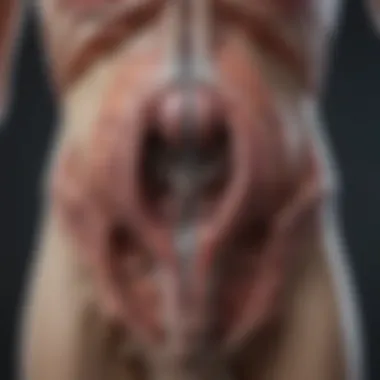Understanding Pelvic Lymph Node Radiation for Prostate Cancer


Intro
Pelvic lymph node radiation plays a key role in the management of prostate cancer. It is vital for both students and healthcare professionals to grasp its significance. Prostate cancer often spread to the lymph nodes, making radiation therapy for the pelvic area a necessary consideration in treatment plans. This article offers a detailed examination of this treatment modality, highlighting essential aspects such as anatomical relevance, treatment planning, side effects, and emerging research.
Understanding the complexities of pelvic lymph node radiation can enhance decision-making for personalized patient care. Careful analysis of the pelvic lymph nodes reveals their functional importance. Moreover, the rationale behind irradiation is fortified by clinical findings and research.
Research Overview
Summary of Key Findings
Recent studies show that pelvic lymph node radiation can improve outcomes for certain patients. Specifically, this approach %increases overall survival rates% and reduces recurrence.
- Improved survival rates noted with targeted radiation.
- Decreased recurrence in high-risk individuals.
- Emerging evidence suggests a lower toxicity profile with new techniques.
Background and Context
Traditionally, prostate cancer treatment focused on surgery and hormone therapy. However, the role of radiotherapy, particularly targeting pelvic lymph nodes, has gained recognition. Studies have indicated that untreated pelvic lymph nodes can harbor microscopic cancer that could grow and spread. Understanding the importance of this area helps frame the evolution of treatment strategies.
Methodology
Experimental Design
Research involved retrospective analyses and randomized clinical trials. These methodologies scrutinized the impacts of pelvic lymph node radiation on outcomes against standard care practices.
Data Collection Techniques
Data was collected through various means, including:
- Patient records and treatment outcomes from clinical databases.
- Surveys focused on quality of life and side effects.
- Imaging techniques to assess nodal involvement pre- and post-treatment.
With these methods, a richer understanding of the effects of radiation therapy on pelvic lymph nodes is obtained. This detail enables a clearer evaluation of the risks and benefits involved in treatment planning.
Prelims to Prostate Cancer
Prostate cancer is a significant health concern for men worldwide. It's essential to understand the impact of this disease, as well as the implications for treatment options, including pelvic lymph node radiation. Prostate cancer's complexity derives from its varied progression and response to treatments, which can differ significantly among individuals.
Understanding prostate cancer involves more than just recognizing symptoms or risks. The disease can affect the quality of life, and the decisions made regarding treatment can have lifelong consequences. This section serves to lay a foundational understanding that will support the discussion of advanced treatments.
Overview of Prostate Cancer
Prostate cancer originates in the prostate gland, an organ responsible for producing seminal fluid. It typically develops slowly and may not cause immediate health issues. However, it can advance and spread to other parts of the body, making timely detection and treatment crucial. Prostate cancer often remains asymptomatic in early stages, which complicates early diagnosis.
The disease can be categorized into several stages based on its size and whether it has spread. Healthcare providers use the Gleason score, which grades the cancer's aggressiveness, and the TNM (Tumor, Node, Metastasis) classification for staging. These classifications help in determining the most effective treatment approach.
A crucial part of understanding prostate cancer is recognizing the potential for it to metastasize. This propensity can lead to lymphatic involvement, particularly in the pelvic lymph nodes, making radiation therapy a critical aspect of treatment planning.
Epidemiology and Risk Factors
Prostate cancer is one of the most common cancers among men, second only to skin cancer. The risk factors associated with prostate cancer include age, family history, and genetic mutations. Men over 50 face higher risks, while those with a family history of the disease are also predisposed.
Key Risk Factors:
- Age: Risk increases significantly after age 50.
- Family History: Having close relatives with prostate cancer can elevate risk.
- Genetics: Certain mutations, such as BRCA1 and BRCA2, are linked to increased susceptibility.
- Ethnicity: African American men have a higher incidence compared to other ethnic groups.
Studies show that while some factors are uncontrollable, lifestyle choices can also play a role in mitigating risks. A balanced diet, regular physical activity, and maintaining a healthy weight are vital considerations.
Understanding these aspects of prostate cancer will be pivotal when exploring treatment options such as pelvic lymph node radiation. It highlights the necessity for personalized treatment strategies and emphasizes the need for patients to engage in discussions about their health with healthcare professionals.


Anatomy of Pelvic Lymph Nodes
Understanding the anatomy of pelvic lymph nodes is crucial in the context of prostate cancer treatment. The pelvic lymphatic system is an intricate network that plays a significant role in both the spread of cancer and the response to treatment. Analyzing the structure and organization of these lymph nodes aids in comprehending how prostate cancer can metastasize and how radiation therapy effectively targets these areas.
Classification of Pelvic Lymph Nodes
Pelvic lymph nodes are categorized based on their anatomical locations and drainage patterns. This classification primarily includes:
- Common Iliac Lymph Nodes: Situated along the common iliac artery, they collect lymph from the pelvic organs.
- Internal Iliac Lymph Nodes: Located in the pelvic cavity, these nodes are significant as they drain lymph from prostate, bladder, and rectum.
- External Iliac Lymph Nodes: Found along the external iliac vessels, they receive drainage from the lower limb and parts of the abdominal wall.
- Obturator Lymph Nodes: These nodes are situated near the obturator internus muscle and are important in prostate cancer because they are often the first to be involved by metastatic spread from the prostate.
Each type has distinct pathways that influence treatment plans. Knowledge of their classification is fundamental for oncologists when assessing the extent of cancer involvement and deciding on radiation fields.
Physiological Role in Immune Response
Pelvic lymph nodes are integral to the body's immune system. They serve as filtration centers for lymph fluid, trapping pathogens, cancer cells, and debris. The nodes contain immune cells, further highlighting their role:
- Lymphocytes: These white blood cells are critical in identifying and attacking cancerous cells and pathogens.
- Macrophages: They help in engulfing and digesting harmful entities.
When prostate cancer is present, the immune landscape within these nodes can be altered, which may influence the efficacy of radiation therapy. Understanding this dynamic interplay between prostate cancer and the immune function of pelvic lymph nodes contributes to developing more targeted and effective treatment strategies.
The Role of Lymph Nodes in Prostate Cancer
The lymph nodes serve a crucial function in the context of prostate cancer, influencing both disease progression and treatment strategies. Understanding the role that these nodes play can deepen insight into cancer behavior and guide therapeutic approaches. This section elucidates how lymph nodes contribute to our understanding of prostate cancer, focusing on metastatic pathways and staging criteria.
Metastatic Pathways of Prostate Cancer
Prostate cancer often initially develops within the prostate gland but can subsequently spread to nearby lymph nodes. This process is known as metastasis, where cancer cells break free from the original tumor and migrate through the lymphatic system or bloodstream.
There are several metastatic pathways:
- Lymphatic Spread: Prostate cancer commonly metastasizes first to the pelvic lymph nodes, subsequently to nodes further away. This progression is significant since it can affect treatment decisions.
- Hematogenous Spread: In some cases, cancer can enter the bloodstream, leading to distant metastases in the bones and other organs.
The pathways of metastasis highlight the lymph nodes' role as integral sites for early detection and intervention. Evaluating whether cancer has spread to these nodes allows for more accurate disease staging and risk assessment, which is paramount in crafting personalized treatment plans.
Importance of Lymph Nodes in Staging
Staging prostate cancer typically involves determining the extent of the disease and how far it has spread. Lymph nodes are key components of this assessment. Accurate staging affects prognosis and therapeutic options. Here are some important aspects:
- Nodal involvement: The presence of cancer in lymph nodes signifies a more advanced stage of prostate cancer, often classified as pN1 in medical coding. This involvement can necessitate aggressive treatment strategies.
- Implications for Treatment: Staging that includes lymph node analysis helps to inform decisions between active surveillance, surgery, and radiation therapy. Certain stages may benefit more profoundly from pelvic lymph node radiation.
Understanding lymph node status is imperative for staging and offers a window into the most effective therapeutic approaches.
Rationale for Pelvic Lymph Node Radiation
Pelvic lymph node radiation plays a crucial role in the treatment of prostate cancer. Understanding the rationale behind this treatment modality is essential for both patients and healthcare providers. The significance of targeting pelvic lymph nodes lies in its potential to enhance treatment outcomes, particularly in cases where the cancer may have spread beyond the primary tumor site.
Concept of Adjuvant Therapy
Adjuvant therapy refers to additional treatment given after the primary treatment to lower the risk of cancer returning. In prostate cancer management, this often involves the combination of surgery, hormone therapy, and radiation.
One of the main goals of adjuvant therapy is to eliminate microscopic disease that may not be detectable through standard imaging techniques.
Research indicates that pelvic lymph node radiation can be beneficial when there is a risk of cancer spreading, particularly in patients who have undergone radical prostatectomy. By irradiating the lymph nodes, healthcare providers aim to reduce the chances of recurrence and improve overall survival rates. Adjuvant radiation can also help manage cases where there are positive surgical margins or elevated prostate-specific antigen (PSA) levels post-surgery.
Clinical Guidelines and Recommendations
Clinical guidelines for pelvic lymph node radiation vary based on numerous factors such as disease stage, patient health, and treatment history. Key organizations like the American Urological Association and the National Comprehensive Cancer Network have established protocols guiding this practice.
Important considerations include:


- Risk assessment: Evaluating the likelihood of lymph node involvement based on clinical and pathological criteria.
- Timing of treatment: Determining the optimal point to initiate radiation, often within a few months post-surgery.
- Radiation techniques: Utilizing advanced planning and delivery methods like intensity-modulated radiation therapy to minimize damage to surrounding healthy tissues.
In view of these guidelines, pelvic lymph node radiation becomes a pivotal component that can enhance the effectiveness of prostate cancer treatment while addressing the unique needs of each patient. This tailored approach underscores the necessity for continuous research and evidence-based practices in this evolving field.
Techniques for Radiation Delivery
The advent of new advancements in the field of oncology has transformed the landscape of treatment methodologies. In the realm of prostate cancer, understanding the techniques for radiation delivery is pivotal for targeting pelvic lymph nodes effectively. The correct application of radiation therapies can enhance treatment efficacy while managing the potential for adverse effects.
Different methods exist for delivering radiation, each with specific benefits and considerations.
Types of Radiation Therapy
There are several types of radiation therapy available for prostate cancer, each designed to cater to the unique demands of individual cases. These include:
- External Beam Radiation Therapy (EBRT): This method employs precise beams of high-energy x-rays to target cancerous cells in the pelvic region. The non-invasive nature of EBRT makes it a preferred option for many patients.
- Intensity-Modulated Radiation Therapy (IMRT): A sophisticated form of EBRT, IMRT utilizes advanced technology to modulate the intensity of radiation beams. This allows for a more focused treatment, minimizing exposure to surrounding healthy tissues and lowering the risk of side effects.
- Stereotactic Body Radiation Therapy (SBRT): This technique entails delivering high doses of radiation in fewer sessions compared to traditional therapies. It is especially advantageous for patients with localized disease, allowing for precision targeting of larger tumors.
- Brachytherapy: In this approach, radioactive seeds are implanted directly into or near the tumor within the prostate. Brachytherapy can provide a concentrated dose of radiation with reduced exposure to the surrounding organs.
Each type of radiation therapy presents its own set of strengths and weaknesses, necessitating careful consideration during treatment planning.
Treatment Planning and Simulation
Effective treatment planning and simulation are fundamental for optimizing the delivery of radiation. A rigorous assessment of the patient's medical history and imaging studies guides the clinical team to make informed decisions. This process typically includes:
- CT scans and MRIs: Imaging techniques are used to delineate the precise location of the tumor and associated pelvic lymph nodes. \n- Dosimetry: This aspect of planning involves calculating the appropriate radiation doses to balance efficacy against potential side effects. \n- Simulation: A preliminary phase that allows a virtual representation of the treatment area. It helps the medical team visualize the setup and adjust parameters to align with the patient's anatomy.
The treatment plan may include a combination of therapies, based on the patient's unique cancer characteristics.
The success of pelvic lymph node radiation hinges on the detailed planning and execution of radiation delivery techniques.
Understanding these techniques empowers both patients and healthcare providers in making informed decisions regarding treatment pathways. As research continues, enhancing these techniques presents new hope for improved outcomes in prostate cancer treatment.
Side Effects and Risks of Pelvic Radiation
The topic of side effects and risks of pelvic radiation holds great significance in the context of prostate cancer treatment. Understanding these aspects is crucial for both patients and healthcare providers. The administration of pelvic lymph node radiation can lead to a range of short-term and long-term effects. These potential outcomes can influence treatment decisions and inform patient expectations.
Benefits of understanding these side effects include:
- Better preparation for patients regarding what to expect during and after treatment.
- More informed discussions between patients and healthcare providers, leading to tailored treatment plans.
- Enhanced ability to manage side effects effectively, improving overall treatment experience.
With this context, let’s look in detail at the short-term and long-term effects associated with pelvic radiation treatment.
Short-term Effects
Short-term effects of pelvic radiation are usually experienced during or immediately after treatment. These effects often arise due to the impact of radiation on healthy tissues adjacent to the targeted lymph nodes. Commonly reported short-term effects include:
- Fatigue: Patients often experience increased fatigue, which may vary in intensity.
- Skin Reactions: Irritation or redness in the treated area is common, resembling sunburn.
- Gastrointestinal Issues: Symptoms may include diarrhea and cramping as the radiation can affect the bowel.
- Urinary Symptoms: Increased frequency of urination, urgency, or discomfort may be felt.
These short-term effects generally resolve over time as the body recovers. However, they can still affect quality of life during the treatment period. Monitoring and supportive care are important to help manage these effects.
Long-term Complications
Long-term complications from pelvic radiation can manifest months or years after treatment has concluded. Understanding these potential outcomes is essential for patients as they navigate life post-treatment. Some long-term complications include:
- Chronic Fatigue: While some fatigue is expected, a persistently higher level can occur in certain individuals.
- Increased Risk of Secondary Cancers: There exists a slight risk of developing other forms of cancer due to exposure to radiation.
- Permanent Changes in Bladder and Bowel Function: These changes could range from incontinence to chronic diarrhea.
- Sexual Dysfunction: Issues such as erectile dysfunction may emerge due to radiation impact on surrounding tissues and nerves.
It is vital for patients who have undergone pelvic radiation to engage in regular follow-ups. Monitoring can help detect complications early and manage them effectively.
Patients can benefit greatly from understanding both short-term and long-term side effects before undergoing treatment. With this knowledge, they can participate actively in discussions with their healthcare providers, leading to enhanced management of their health throughout the radiation experience.


Post-treatment Monitoring and Follow-Up
Post-treatment monitoring and follow-up plays a critical role in managing the quality of care for prostate cancer patients who have undergone pelvic lymph node radiation. This phase involves systematic evaluations to ensure treatment efficacy and to address potential side effects. Consistent follow-up allows healthcare providers to make timely interventions and adjustments in treatment plans based on the patient's condition.
Assessment of Treatment Efficacy
The assessment of treatment efficacy is essential to understand how well pelvic lymph node radiation is working. This usually includes follow-up imaging studies, such as CT scans or MRIs, to monitor for any signs of cancer recurrence or metastasis. Physicians may also rely on tumor markers and PSA levels to gauge the success of the treatment. Regular assessments not only contribute to maintaining a clear prognosis but also help in adapting future treatment strategies if necessary.
Patients should be aware that different health systems may have varying protocols for assessments. Some might recommend more frequent evaluations in the initial months post-treatment, gradually moving to less frequent visits as stability is achieved. A collaborative approach between healthcare providers and patients is key to ensuring all nuances of treatment response are understood.
Management of Side Effects
Effective management of side effects is a significant component of post-treatment care. Patients undergoing pelvic radiation may experience various side effects, including fatigue, urinary dysfunction, or gastrointestinal issues. Addressing these complications promptly can significantly improve the patient's quality of life.
Here are some common management strategies:
- Urinary Symptoms: Medications or bladder training techniques may help mitigate issues such as urgency or frequency.
- Gastrointestinal Issues: Dietary modifications and medications can alleviate discomfort due to radiation proctitis.
- Fatigue Management: Encouraging light physical activity and setting a restful routine can help combat fatigue that patients may experience.
"Monitoring should not just focus on cancer regression but also ensure that the patient's overall health and well-being remain a priority."
Tailored support through professional counseling or support groups can also be beneficial. By managing side effects effectively, healthcare teams can enhance the overall experience for patients following treatment.
Post-treatment monitoring and follow-up represent a vital component of the continuum of care for prostate cancer patients. Thorough assessments and proactive management of side effects are fundamental to optimizing outcomes after pelvic lymph node radiation.
Emerging Research and Future Directions
Emerging research in pelvic lymph node radiation signifies a pivotal point in prostate cancer therapy. With ongoing advancements in medical technology and a deeper comprehension of prostate cancer biology, it has become essential to examine the evolving landscape of treatment approaches. This section highlights the innovations in radiation techniques, and the potential for personalized medicine, underscoring their implications for clinical practice and patient outcomes.
Innovations in Radiation Techniques
The field of radiation therapy is continuously evolving, integrating new technologies and methodologies that increase treatment precision. Among the latest advancements are techniques such as intensity-modulated radiation therapy (IMRT) and proton therapy. IMRT allows for targeted doses of radiation to the prostate and pelvic lymph nodes, minimizing exposure to surrounding healthy tissues. This capability can lead to reduced side effects, enhancing the overall quality of life for patients.
Moreover, advances in imaging technologies, such as Positron Emission Tomography (PET) and Magnetic Resonance Imaging (MRI), enable clinicians to visualize tumors with greater accuracy. Improved imaging techniques inform better treatment planning, facilitating the identification of lymph node involvement and the tailoring of radiation delivery.
Another promising development is the application of stereotactic body radiation therapy (SBRT). This method delivers high doses of radiation in fewer sessions, potentially improving convenience for patients while maintaining efficacy. With ongoing clinical trials, the results may redefine standard treatment protocols, suggesting new avenues for long-term patient management.
Potential for Personalized Medicine
Personalized medicine represents a significant turning point in cancer care, offering treatments tailored to the individual’s genetic makeup, health status, and tumor characteristics. For prostate cancer, the potential for applying personalized medicine to pelvic lymph node radiation therapy is vast.
Genetic profiling of tumor tissues can identify specific biomarkers that predict response to radiation. For instance, certain patients may benefit more from intensified radiation protocols based on their genetic makeup. Conversely, some could avoid unnecessary radiation, thus reducing the risk of adverse side effects.
Furthermore, the integration of biorepositories and databases for genetic research can facilitate the development of decision-making algorithms. These algorithms can aid in selecting optimal radiation doses and schedules tailored to individual patient scenarios, optimizing treatment outcomes.
As we look ahead, collaboration among oncologists, radiologists, and researchers will be critical in curating treatment plans that consider the multifaceted aspects of each patient's disease. Clinical trials focusing on personalized approaches will likely drive this shift, paving the way for more effective and individualized cancer therapies.
In summary, ongoing research will not only enhance radiation techniques but also align them with the principles of personalized medicine, ultimately improving clinical outcomes for prostate cancer patients.
Closure
The conclusion is a critical aspect of this article as it encapsulates the essential insights gained regarding pelvic lymph node radiation in the treatment of prostate cancer. Understanding the significance of this treatment modality is necessary for both patients and healthcare providers. The integration of radiation therapy not only addresses potential metastases but also enhances standard treatment strategies, therefore optimizing patient outcomes.
Summary of Key Insights
In summation, pelvic lymph node radiation plays a crucial role in the comprehensive management of prostate cancer. Key insights include:
- Treatment Efficacy: Radiation therapy has demonstrated effectiveness in reducing recurrence rates in patients with prostate cancer, particularly where lymph node involvement is suspected.
- Side Effects Management: Awareness of potential short and long-term side effects is essential for effective patient education and management post-treatment.
- Emerging Research: Ongoing innovations in radiation technology, including advanced imaging techniques, continue to improve precision and minimize collateral damage to surrounding tissues.
- Guideline Revisions: Continuous updates to clinical guidelines reflect the evolving understanding of when and how to incorporate pelvic lymph node radiation into treatment plans.
Implications for Future Research
The future of pelvic lymph node radiation in prostate cancer treatment is ripe for exploration. Several vital areas require attention:
- Personalized Treatment: Future studies could focus on tailoring radiation doses based on individual patient factors, aiming for maximum efficacy while minimizing adverse effects.
- Longitudinal Studies: There is a need for comprehensive studies that track long-term outcomes in patients who undergo this specific type of radiation therapy.
- Integration with Immunotherapy: Research could investigate the synergetic effects of combining lymph node radiation with immunotherapeutic approaches.
- Patient-Centered Approaches: Gathering data on patient experiences and preferences can inform the development of better discussions about treatment choices.
Ultimately, further investigation into these areas could enhance treatment protocols and thereby improve the quality of life for prostate cancer patients. As our understanding deepens, the hope is to provide a more nuanced, sophisticated approach to care, empowering patients along their journey.







